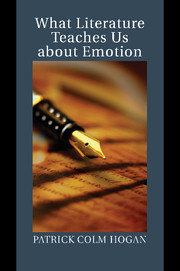Book contents
- Frontmatter
- Contents
- List of Figures
- Acknowledgments
- Introduction: Studying Literature Studying Emotion
- 1 Fictions and Feelings
- 2 What Emotions Are
- 3 Romantic Love
- 4 Grief
- 5 Mirth
- 6 Guilt, Shame, Jealousy
- 7 From Attachment to Ethical Feeling
- 8 Compassion and Pity
- Afterword: Studying Literature Shaping Emotion
- Works Cited
- Index
- Title in the series
Introduction: Studying Literature Studying Emotion
Published online by Cambridge University Press: 03 May 2011
- Frontmatter
- Contents
- List of Figures
- Acknowledgments
- Introduction: Studying Literature Studying Emotion
- 1 Fictions and Feelings
- 2 What Emotions Are
- 3 Romantic Love
- 4 Grief
- 5 Mirth
- 6 Guilt, Shame, Jealousy
- 7 From Attachment to Ethical Feeling
- 8 Compassion and Pity
- Afterword: Studying Literature Shaping Emotion
- Works Cited
- Index
- Title in the series
Summary
This book sets out to integrate literary insights with work from neuroscience, psychology, philosophy, and elsewhere in order to contribute to the ongoing interdisciplinary research program in emotion. Drawing on those sources, but stressing the particular value of literature, it treats the general structure of emotion, both egoistic and empathic, as well as particular emotions including romantic love, mirth, grief, guilt, shame, and jealousy. It also takes up the increasingly important connection between emotion study and ethics, proposing some general principles for understanding this connection both within and outside literary works.
Research in emotion has advanced remarkably in the past two or three decades. Our understanding of human feeling and motivation is incomparably greater than it was forty years ago. This advancement is due largely to the work of research scientists. These scientists have, to a great extent, been operating in the general context of cognitive science. One of the main lessons of cognitive science is that understanding the human mind requires the integration of work from a broad range of disciplines. For example, linguistics is advanced by the study of metaphor while itself contributing to genetics; philosophical reflections orient anthropological investigations that themselves suggest topics for neurological study. Many of the great successes of cognitive science come from the fact that the research programs it has put forward are interdisciplinary. Cognitive science has forced researchers in traditional disciplines to explore other techniques of examining a given topic, incorporating other data, other theories, other approaches, and other hypotheses.
- Type
- Chapter
- Information
- What Literature Teaches Us about Emotion , pp. 1 - 10Publisher: Cambridge University PressPrint publication year: 2011



